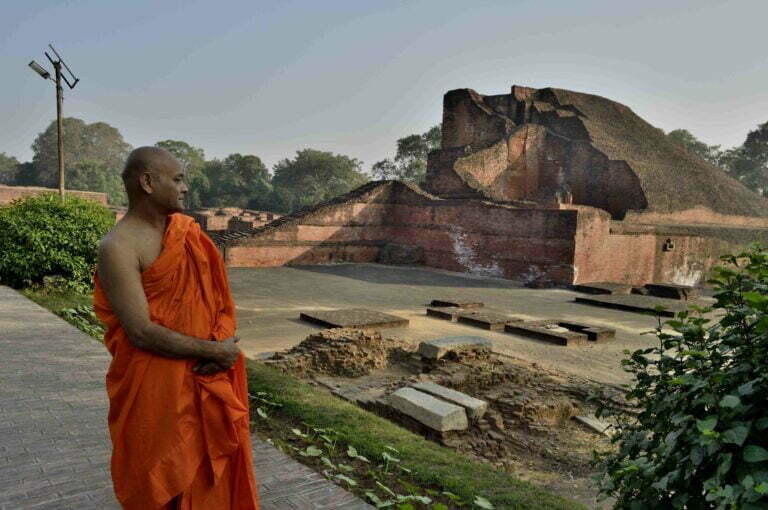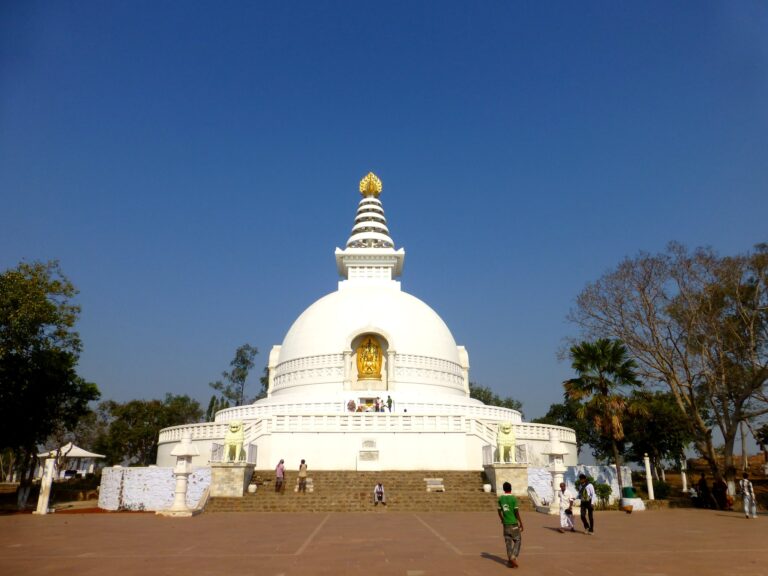The Mahabodhi Temple Complex, located in Bodh Gaya, Bihar, India, stands as a testament to the profound spiritual journey of Siddhartha Gautama, who, under the Bodhi Tree, attained enlightenment and became the Buddha. This sacred pilgrimage site is one of the most revered in the Buddhist world, drawing millions of devotees and visitors each year.
Mahabodhi Temple Complex
Believed to have been initially constructed by Emperor Ashoka in the 3rd century BCE, the Mahabodhi Temple Complex underwent subsequent modifications and renovations by various dynasties, including the Guptas and the Pala rulers. The temple’s architectural style reflects classical Indian design, characterized by a towering spire, intricate carvings, and a central tower that soars into the sky. The temple complex also includes a meditation garden, shrines, and a sacred pond, creating a serene environment conducive to contemplation.
At the heart of the Mahabodhi Temple Complex is the Mahabodhi Temple itself, housing a large gilded statue of the Buddha in a deep state of meditation. The temple structure showcases fine carvings depicting scenes from the Buddha’s life as well as mythological narratives. The main shrine is a place of worship and reverence where devotees gather to pay homage to the Buddha and meditate on the path to enlightenment.
The Bodhi Tree, an integral part of the complex, is said to be a descendant of the original tree under which the Buddha attained enlightenment. Pilgrims from around the world visit this sacred tree, viewing it as a symbol of spiritual awakening.
Throughout the year, the Mahabodhi Temple Complex hosts various festivals, with the Bodh Gaya Mahotsav being a significant celebration commemorating the Buddha’s enlightenment. During this festival, the complex comes alive with prayer, meditation, and cultural events, attracting pilgrims and tourists alike.
Visitors to the Mahabodhi Temple Complex are greeted by a tranquil atmosphere, marked by the sounds of chanting, the rustling of leaves in the Bodhi Tree, and the scent of incense wafting through the air. Pilgrims often engage in circumambulation, walking around the main temple in a clockwise direction, symbolizing the path to enlightenment.
The Mahabodhi Temple Complex, with its rich history, spiritual significance, and architectural splendor, continues to be a beacon for those seeking spiritual enlightenment and a source of inspiration for people worldwide. Its enduring legacy resonates not only as a historical monument but as a living testament to the profound teachings of the Buddha.
Mahabodhi Temple Facts
1. When was the Mahabodhi Temple built? The Mahabodhi Temple in Bodh Gaya, Bihar, is believed to have been originally built by Emperor Ashoka in the 3rd century BCE.
2. What is the significance of the Mahabodhi Temple? The Mahabodhi Temple is highly significant as it marks the spot where Siddhartha Gautama, the Buddha, is said to have attained enlightenment.
3. What are the main features of the Mahabodhi Temple architecture? The temple exhibits classical Indian architecture, featuring a soaring spire, intricate carvings, and a large central tower. The temple complex also includes the Vajrasana, or Diamond Throne, beneath the Bodhi Tree, where the Buddha is believed to have attained enlightenment.
4. Is the Mahabodhi Temple a UNESCO World Heritage Site? Yes, the Mahabodhi Temple Complex was inscribed as a UNESCO World Heritage Site in 2002, acknowledging its cultural and religious significance. The designation recognizes not only the historical importance of the site but also its enduring influence on Buddhist art and architecture.
5. What is the Bodhi Tree at the Mahabodhi Temple? The Bodhi Tree at the temple is a descendant of the original tree under which the Buddha is said to have attained enlightenment. It is considered a symbol of enlightenment and is highly venerated.
6. How has the Mahabodhi Temple changed over the centuries? The temple has undergone various modifications and renovations over the centuries. It was restored during the Gupta period and underwent further renovations during subsequent dynasties.
7. What festivals are celebrated at the Mahabodhi Temple? The most significant festival celebrated at the Mahabodhi Temple is Bodh Gaya Mahotsav, which commemorates the Buddha’s enlightenment. Other festivals include Buddha Purnima, marking the Buddha’s birth, enlightenment, and death.
8. Are there any restrictions for visitors to the Mahabodhi Temple? Visitors are generally welcome, but there are guidelines for behavior and a dress code to maintain the sanctity of the temple. Additionally, photography may be restricted in certain areas.
9. What is the Diamond Throne (Vajrasana) at the Mahabodhi Temple? The Diamond Throne is a stone platform marking the spot where the Buddha is believed to have sat in meditation and attained enlightenment. It is an important focal point within the temple complex.
10. How is the Mahabodhi Temple linked to the spread of Buddhism? The Mahabodhi Temple in Bodh Gaya is a pilgrimage site for Buddhists worldwide and is associated with the dissemination of Buddhist teachings. It holds immense historical and religious significance in the context of Buddhism’s origins.
Mahabodhi Temple History
The Mahabodhi Temple Complex stands as one of the four sacred sites associated with the life of the Lord Buddha, particularly linked to his attainment of Enlightenment. The initial construction of the first temple dates back to the 3rd century B.C. under the reign of Emperor Asoka, and the present temple, dating from the 5th or 6th centuries, remains one of the earliest Buddhist temples built entirely in brick and still standing in India, reflecting the late Gupta period.
Situated in Bodh Gaya, the current Mahabodhi Temple Complex encompasses the grand 50-meter-high temple, the Vajrasana, the sacred Bodhi Tree, and six additional sacred sites connected to Buddha’s enlightenment. These sites are surrounded by well-maintained ancient votive stupas and protected by inner, middle, and outer circular boundaries. Additionally, a seventh sacred place, the Lotus Pond, is situated outside the enclosure to the south, creating a spiritually significant ensemble with a unique architectural layout.
Archaeologically, the Mahabodhi Temple Complex is unparalleled in its significance, capturing the events associated with the time Lord Buddha spent there and documenting the evolving worship practices. Emperor Asoka’s contributions in the 3rd century, including the construction of the first temple, balustrades, and memorial columns, laid the foundation for the complex’s historical and cultural importance.
The Mahabodhi Temple Complex witnessed subsequent evolution with the construction of sanctuaries and monasteries by foreign kings over the centuries. Key sacred places within the complex include the giant Bodhi Tree, believed to be a direct descendant of the original tree where Buddha attained enlightenment, and various locations where Buddha spent distinct weeks during his enlightenment journey. The Ajapala Nigrodh Tree, Ratnaghar Chaitya, and the Lotus Pond are integral to the narrative of Buddha’s enlightenment, each marked with specific significance and historical markers.
Adjacent to the Bodhi Tree stands the Vajrasana, a polished sandstone platform attached to the main temple. Emperor Asoka originally installed this diamond throne to commemorate the spot where Buddha sat and meditated. The surrounding balustrade, once encircling the site under the Bodhi Tree, featured sculpted human faces, animals, and intricate decorative details, with a few original pillars still in situ.
Along the central path towards the main temple, a small shrine displays standing Buddha statues and footprints carved on black stone, dating back to Emperor Asoka’s declaration of Buddhism as the state religion. The complex also features a gateway rebuilt by Emperor Asoka, a building housing Buddha and Bodhisattva statues, and a memorial to a Hindu Mahant from the 15th and 16th centuries. South of the pathway, a cluster of votive stupas, varying in shape and size, were erected by kings, princes, noblemen, and laypeople.
Philosophically and culturally, the Mahabodhi Temple Complex holds immense significance as it marks the pivotal moment in Lord Buddha’s life when he attained Enlightenment. This event, which occurred under the Bodhi Tree, shaped human thought and belief, making the complex the holiest place of Buddhist pilgrimage globally. Revered as the cradle of Buddhism in the history of mankind, the Mahabodhi Temple Complex continues to be a beacon of spiritual and historical importance, drawing pilgrims and visitors from around the world.


Bodhi tree Buddhism. Great place